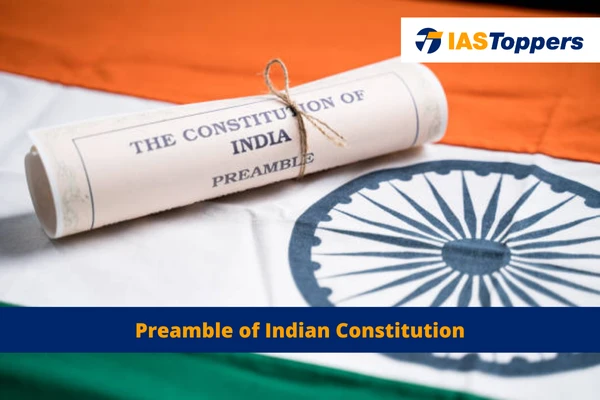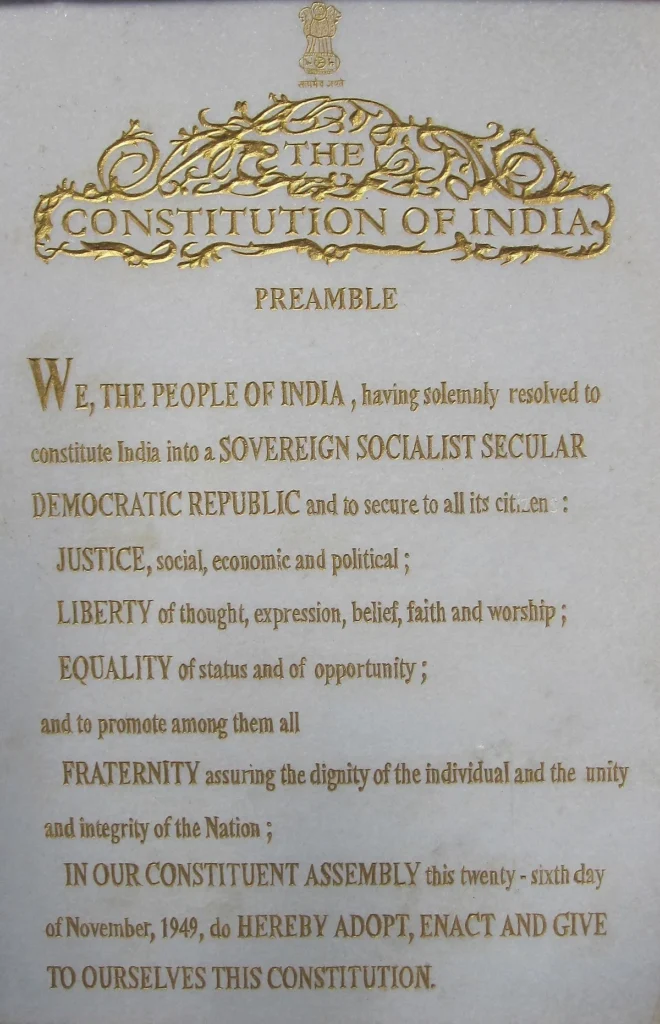The Preamble of the Indian Constitution is a brief introductory statement that sets out the guiding purpose and principles of the Constitution. It indicates the source from which the document derives its authority, meaning the people of India. It outlines the ideals that must guide Indian democracy and declares India to be a Sovereign Socialist, Secular, Democratic, Republic, committed to Justice, Equality, and Liberty for the people.
Preamble of Indian Constitution will be helpful for UPSC IAS Exam preparation. GS Paper-2 Indian Polity.
Table of Content
- What is Preamble of the Indian Constitution?
- Preamble of the Indian constitution
- Source of authority of the Constitution
- Nature of Indian State
- Objectives of the Preamble of the Indian Constitution
- Date of adoption of the Constitution
- Preamble as a part of the Constitution
- Key Facts about Preamble of Indian Constitution
- Conclusion
- Frequently Asked Questions (FAQs)
What is Preamble of the Indian Constitution?
- Meaning: A preamble to the constitution is an introductory and expressionary statement in a document that explains the document’s purpose and underlying philosophy.
- The World’s first constitution to have a preamble was American Constitution.
- It contains the summary or essence of the Constitution.
Preamble of the Indian constitution
- Preamble to the Indian Constitution is based on the ‘Objectives Resolution’.
- Objective Resolution was drafted and moved by Pandit Nehru.
- The 42nd Constitutional Amendment Act (1976) added three new words–Socialist, Secular and Integrity to the preamble.
Source of authority of the Constitution
We, the people of India.
- This phrase states that the constitution of India derives its authority from the people of India.
Nature of Indian State
Sovereign:
- Sovereign means India is neither a dependency nor a dominion of any other nation.
- India is an independent state.
- India is free to conduct its both internal and external affairs.
- India’s membership in the Commonwealth of Nations and its membership in the United Nations Organisation (UNO) does not limit its sovereignty.
Socialist:
- The term ‘Socialist’ was added by the 42nd Amendment in 1976.
- Indian socialism is a ‘democratic socialism’ and not a ‘communistic socialism’ (also known as ‘state socialism’).
- State socialism involves nationalizing all means of production and distribution and abolishing private property.
- Democratic socialism holds faith in a ‘mixed economy’ where both public and private sectors co-exist side by side.
- Indian socialism is a blend of Gandhismand Marxism.
- However, it is leaning heavily towards the Gandhian socialism.
- New Economic Policy (1991) of liberalisation, privatisation and globalisation has, however, diluted the socialist credentials of the Indian State.
Secular:
- The term ‘Secular’ was added by the 42nd Constitutional Amendment Act of 1976.
- However, in 1974, Supreme Court said the word ‘secular state’ was not expressly mentioned in the Constitution, Constitution makers established provisions of Articles 25 to 28 (guaranteeing the fundamental right to freedom of religion) that have been included in the Constitution.
- Indian Constitution embodies the positive concept of secularism.
- This means all religions in our country (irrespective of their strength) have the same status and support from the state.
Democratic:
- Democratic polity in the preamble is based on the doctrine of popular sovereignty.
- It means possession of supreme power by the people.
Republican:
- Democratic polity can be classified into two categories: monarchy and republic.
- In a monarchy, the head of the state (usually king or queen) enjoys a hereditary position.
- Example: Britain.
- In a republic, the head of the state is elected directly or indirectly for a fixed period.
- Example: USA.
- Therefore, the term ‘republic’ in India’s Preamble indicates India has an elected head called the president.
Objectives of the Preamble of the Indian Constitution
- Justice: social, economic and political.
- Liberty: of thought, expression, belief, faith and worship.
- Equality: of status and opportunity.
- Fraternity: assuring the dignity of the individual and the unity and integrity of the nation.
Date of adoption of the Constitution
- The Indian Constitution was adopted on the 26th November 1949.
- Most of the article came into force on 26th January 1950.
- Article 394: It states Article 394 itself and articles 5, 6, 7, 8, 9, 60, 324, 366, 367, 379, 380, 388, 391, 392 and 393 shall come into force at once, and the remaining provisions of this Constitution shall come into force on the twenty-sixth day of January 1950.
- 26th January was selected because on that day in 1930, the Declaration of Indian Independence (Purna Swaraj) was proclaimed by the Indian National Congress.
Preamble as a part of the Constitution
- Berubari Union Case (1960): Supreme Court said Preamble is not a part of the Constitution.
- Kesavananda Bharati case (1973): Supreme Court rejected the earlier opinion and held that Preamble is a part of the Constitution.
- LIC of India case (1995): Supreme Court again held that the Preamble is an integral part of the Constitution.
Key Facts about Preamble of the Indian Constitution
- Calligrapher of the Indian Constitution: Prem Behari Narain Raizada (1901–1966)
- Chief artist behind the illustration of the original Indian Constitution: Nandalal Bose
- He was assisted by his disciple Beohar Rammanohar Sinha.
- Designed and decorated the Preamble page of the Indian Constitution: Beohar Rammanohar Sinha of Jabalpur.
Conclusion
The Preamble of the Indian Constitution outlines the objectives of the Constitution, which are justice, liberty, equality, and fraternity to maintain the integrity and unity of the nation. It was adopted on November 26, 1949, and came into effect on January 26, 1950, which is celebrated as Republic Day in India.
Ref: Source-1
FAQs (Frequently Asked Questions)
In Which case the Supreme Court said the preamble is not part of the Constitution?
In the verdict of the Berubari Case (1960) the Supreme Court said the preamble is not part of the Constitution.
Is the preamble part of the Constitution?
Yes, the Supreme Court in the Kesavananda Bharati Case (1973) verdict said that the preamble is a part of the Constitution.
What is the importance of the preamble?
The Preamble acts as a concise and important guide, reflecting the Constitution’s principles, deriving authority from the people, outlining legislative objectives, embodying ideals, providing direction and purpose, and encompassing socio-economic goals achievable through constitutional means.
Who said the preamble is the soul of the Indian Constitution?
Pandit Thakur Das Bhargava called the preamble is the soul of the Indian Constitution.
Who proposed the preamble in the Constitution?
The Preamble is based on the ‘Objectives Resolution’, which was drafted and moved by Pandit Nehru, and adopted by the Constituent Assembly.
Who called Preamble the identity card of the Constitution?
N. K. Palkhivala called the Preamble the identity card of the Constitution.
Who said Preamble is the keynote to the Constitution?
Ernest Barker said the Preamble is the keynote to the Constitution.
Who called the Preamble as Political Horoscope of the Constitution?
K.M. Munshi, a drafting committee member called the Preamble a Political Horoscope of the Constitution.
Why is Preamble called the preface of the Indian Constitution?
The Preamble is called the preface of the Indian Constitution because it contains the philosophy on which the entire Indian Constitution is built.



